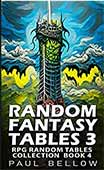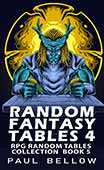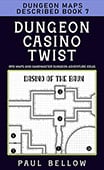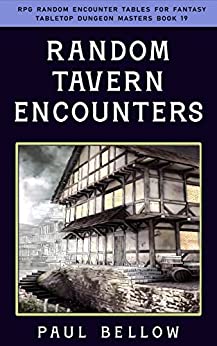There’s an undeniable thrill in mastering the arcane, an electricity that crackles in the imagination whenever you hear the words “high-damage wizard.” With the launch of D&D 5.5e in 2024, the spell-slinger’s role feels more dynamic and dangerous than ever. For many players, the appeal is obvious: tilting the cosmic odds until you’re the inferno at the heart of every battle, raining devastation on your foes. But beneath the allure of sky-high damage numbers lies the delicate dance every wizard knows all too well—how do you harness maximum power without becoming mere ashes in the first reprisal?
Wizards, especially those built for pure damage, are glass cannons epitomized. They hold the potential to obliterate encounters in a blaze of magic, commanding awe and terror in equal measure. Optimizing for damage means squeezing every bit of potential from your limited spell slots and fragile hit points, always knowing that a single failed dodge could spell your doom. This razor-edge vulnerability is not a flaw but a feature; it’s the crucible that forges the wizard’s myth. Be sure to check out our wizard backstory generator too if you get a chance!
The real trick (what sets the unforgettable Wizards apart from mere fireworks bent on self-destruction) is balancing their infernal offensive might with shrewd survivability and, perhaps most importantly, adaptability. A high-damage build shouldn’t mean a boring one. Wizards can sizzle with flavor and backstory without ever compromising their dominion over battlefield slaughters. With the right mix of spell choices, subclass features, and tactical acumen, you can have the best of both worlds: memorable roleplay and mechanical mayhem.
If you’ve ever been the squishy spellcaster, you know the anxiety of initiative rolls and the panic of being in a goblin’s crosshairs. But you also know the primal satisfaction when your Fireball clears a dozen foes or a Disintegrate ends the villain’s grand monologue. Leaning into this risk, rather than away from it, is what makes the high-damage Wizard in D&D 5.5e so exhilarating.
So whether your wizard is an eldritch scholar cackling from behind an anti-magic tome, a flamboyant duelist blending blade and incantation, or a stoic battlefield general orchestrating mass destruction with clinical precision, know this: maximizing damage is not about dumping flavor or narrative hooks. It’s about writing your legend with lightning and flame. This guide will show you how—without losing your soul (or your place at the table).
Choosing the Right Wizard Subclass
Subclass selection matters more than ever in D&D 5.5e. Wizards enjoy a sprawling buffet of arcane traditions, each bringing its own flavor and mechanical edge. If your heart is set on raw power, the Evocation School calls to mind everything a fire-hungry mage desires. With features like Sculpt Spells and Empowered Evocation, this subclass lets you nuke clusters of foes without singeing your friends and stack even more force onto every bolt and blast. Evocation turns every area spell into a calculated demolition—damage with surgical precision.
Try my AI Tabletop RPG generators...and an extensive library of content!
On the opposite side of the coin lies the School of War Magic. Damage is scintillating, but surviving long enough to deliver that meteor swarm is a tactician’s delight. War Magic wizards blend offense with potent defenses like Arcane Deflection and Durable Magic, allowing you to stand a little closer to the frontlines while keeping your concentration unbroken and spell saves fearsome. In 5.5e, with some new tweaks, this subclass is a goldmine for anyone who wants to blast without always hiding behind the paladin.
Bladesinging, meanwhile, offers a breathtaking fusion: spellcasting entwined with swords. While not a top contender for raw spell damage, the flexibility to dive into melee for a high-damage green-flame blade or booming blade, dodge out, and unleash spells is almost unmatched. Their Bladesong feature grants AC and mobility, crucial for survival, which lets you gamble on risky plays and stylish finishes.
Other subclasses may sneak into your shortlist—Chronurgy’s time-twisting control can turn a failed save into a kill shot, while Divination’s portent dice might tip the odds for a crucial Disintegrate. Each Wizard tradition bends the boundaries of devastation in its own way, shaping your playstyle and approach to every encounter.
| Subclass Name | Main Damage Features | Secondary Combat Benefits |
|---|---|---|
| Evocation | Sculpt & Empowered Spells, elemental spell boosts | Party-safe AoEs, increased spell power |
| War Magic | Arcane Deflection, Power Surge | Higher survivability, improved concentration |
| Bladesinging | Melee cantrips with spell enhancements | AC boost, extra speed, defensive singing |
| Chronurgy | Temporal Shunt, clock shifting for advantage | Control saves, time manipulation |
| Divination | Portent dice to manipulate spell attacks | Predict saves, boost reliability |
| Abjuration | Arcane Ward absorbs damage | Stronger defenses, occasional spell boost |
| Necromancy | Improved damage with necrotic spells | Undead minions for protection |
| Conjuration | Minor damage, battlefield manipulation | Flexible positioning, summon distractions |
| Illusion | Indirect damage through deception | Invisibility, control, misdirection |
| Enchantment | Manipulate enemies into harming each other | Control, indirect offense |
Ultimately, your subclass is more than a bundle of numbers—it’s your arcane identity. The pure math of Evocation tempts min-maxers, but the nimble tactics of War Magic or the daring style of Bladesinging might sing to your narrative soul. Sometimes the right subclass isn’t the one with the highest theoretical output, but the one that feels like your character’s magical fingerprint.
⚔️ Fantasy RPG Random Tables Books
Make life as a Gamemaster easier…
If you play Dungeons & Dragons, Pathfinder, or other fantasy RPGs, this
RPG random tables series
is packed with encounters, NPCs, treasure, and more. Available in eBook or print—either way, you’ll have a wealth of adventure ideas at your fingertips.
Remember, “high damage” can mean savage nova rounds or consistent, reliable threats. In the hands of a master, even a Bladesinger can stack up to an Evoker with a well-timed cantrip and some luck. Be honest with what excites you—whether it’s roasting crowds or orchestrating set-piece duels.
Must-Have Spells for Maximum Damage
Building a high-damage wizard is a balancing act between flashy, memorable attacks and tactical reliability. D&D 5.5e amplifies the options: spell slots are precious, and the spells you prepare need to hit hard, hit often, and adapt on the fly. While it’s tempting to simply pick the biggest dice rolls, versatility trumps over-specialization every time.
Area-of-effect spells remain the bread and butter for any would-be magical rainstorm. Fireball, the beloved classic, dominates the midgame with sheer volume; Meteor Swarm obliterates the late game. However, don’t ignore precise, single-target spells like Disintegrate or Finger of Death—sometimes it’s better to blast one monstrous foe than scatter damage across a horde.
Action economy means casting spells that rarely waste your turn and punish enemies for clumping or exposing themselves. Spells that scale well with higher levels or can target multiple enemies should be your bread and butter. Above all, optimize your spell save DC—no damage matters if your enemies keep shrugging it off.
Lastly, your damage arsenal should be flexible. Pack elemental variety. Know when to swap between crowd control and raw destruction. The most dangerous wizard is the one whose enemies can never predict what horror comes next.
Essential Damage Spells for High-Damage Wizards:
- Magic Missile: Always hits, bypasses most defenses, great for finishing
- Scorching Ray: Multiple beams, excellent for focusing fire
- Fireball: Iconic area nuke, insane range and radius
- Lightning Bolt: Line AoE, great for blasting clustered foes in corridors
- Ice Storm: Combo of bludgeoning/cold, hinders movement
- Synaptic Static: Psychic AoE, messes with enemy attacks if they fail save
- Melf’s Minute Meteors: Sustained mini-explosions for crowd thinning
- Cone of Cold: Big area, cold damage, works on fire-resistant mobs
- Wall of Fire: Persistent area denial AND damage
- Vitriolic Sphere: Delayed acid damage, great for tough targets
- Disintegrate: Massive single-target force damage, vaporizes if reduced to 0
- Chain Lightning: High-level chaining, great against grouped foes
- Delayed Blast Fireball: Set up for timing and giant damage
- Finger of Death: Necrotic, handy for creating undead too
- Sunburst: Radiant damage, blinds enemies, huge radius
- Prismatic Spray: Chaos, chance to hit with multiple elements
- Horrid Wilting: Necrotic AoE, excellent vs. water elementals/plant creatures
- Crown of Stars: Bonus action casting, mobile damage
- Power Word Kill: Guaranteed kill if target is weak enough
- Meteor Swarm: Legendary level battlefield deletion
Use these spells thoughtfully—never become the one-trick bombardier. Area spells clear cannon fodder, but big single-target attacks drop legendary monsters. Keep an eye on resistance and immunity, and always have more than one damage type in your pocket.
Even a pure-damage Wizard needs tricks up their sleeve. Don’t ignore spells like Counterspell, Misty Step, or Hold Monster when prepping for a day of adventure. Being able to swap seamlessly between offense, defense, and utility is the mark of a true archmage.
Resist the temptation to fill your spellbook with nothing but fire and thunder. Sometimes, the most devastating spell is the one that ends a fight before it begins—or protects you long enough to get the last word in.
Feats and Stats That Boost Your Power
A high-damage Wizard lives and dies by their statistics. Intelligence is the undisputed king: every spell save DC, attack bonus, and arcane trick leans on that number. When given a stat boost, pump Intelligence—nothing else comes close for raw spell power. After Intelligence, prioritize Constitution for concentration checks and a small blessing of hit points, with Dexterity for initiative and survival.
Feats offer a chance to twist the normal limits, turning a good mage into a walking disaster. The right feat can punch through resistances, sharpen your casting under pressure, or even cheat death itself. In D&D 5.5e, feat selection can radically change how your Wizard delivers pain.
Consider Elemental Adept to bypass common resists, or Spell Sniper to double your reach and ignore half/three-quarters cover. Even feats like War Caster, often considered defensive, let you keep spells running while chaos swirls around you. Mobility, initiative, and concentration are the silent partners of every damage spell.
⚔️ Fantasy RPG Random Tables Books
Make life as a Gamemaster easier…
If you play Dungeons & Dragons, Pathfinder, or other fantasy RPGs, this
RPG random tables series
is packed with encounters, NPCs, treasure, and more. Available in eBook or print—either way, you’ll have a wealth of adventure ideas at your fingertips.
Never underestimate the value of going early in combat. An Arcane Alertness feat or anything to boost initiative may save your life and give you the opening salvo. If you can move, survive, and cast first, you set the pace for the whole encounter.
Feats & Stat Strategies for Damage Wizards:
- Intelligence ASI: Always first for spell DC and attack rolls
- Elemental Adept: Ignore resistance to favored element, re-roll 1s
- War Caster: Advantage on concentration, react with spells
- Spell Sniper: Double range, ignore cover, cantrip bonus
- Resilient (Constitution): Boost con/save, concentration holding
- Alert: +5 initiative, no surprise—amazing for safe first rounds
- Lucky: Reroll key saves, spell attacks, or bad rolls
- Tough: Extra HP for more survive-and-blast
- Mobile: Dash around the field with ease, escape melee
- Metamagic Adept: Tweak spell range, power, or timing (5.5e Tasha’s rules)
- Fey Touched: Misty Step + an extra spell, for mobility
- Telekinetic: Bonus action shove, increased tactical mobility
- Defensive Duelist: If you wade into melee as a Bladesinger
Never trade away all your defenses for another minor cantrip boost. Remember: the world’s deadliest Wizard is a living one. Your power means nothing if a lucky goblin arrow puts you out of the game.
In D&D 5.5e, defenses scale quickly. Don’t lag behind. Smart feat selection means you can keep casting through fireballs—yours and theirs. And never, ever forget that sometimes the best defense is a good offense…but only if you live to cast another round.

Gearing Up: Magic Items and Equipment
In the magical arms race that is D&D 5.5e, smart itemization can make the high-damage wizard truly terrifying. From classic wands that amplify your favorite spells to robes shimmering with arcane wards, magic items aren’t just loot—they’re your arsenal, your insurance, your legend made tangible.
Staves and wands are the iconic tools of destruction. A Staff of Power or Wand of the War Mage turns standard-issue spells into epic-level threats. Staves often come with charge-based spellcasting, letting you conserve spell slots for those true do-or-die moments, while wands can boost both accuracy and spell DCs with every swing.
Robes and spellbooks should not be ignored. A Robe of the Archmagi makes you the envy of every caster, while a spellbook loaded with extra cantrips or special rituals can unlock versatility most foes never see coming. New 5.5e itemization options provide more tailored benefits, so always be on the lookout.
| Item Name | Damage-Related Effect | Recommended Tier to Acquire |
|---|---|---|
| Wand of the War Mage | +1-3 to spell attack rolls | Early to mid |
| Staff of Power | Bonus to attack, damage, and AC; store/manage slots | Mid to late |
| Robe of the Archmagi | Higher spell DCs, huge AC/Save boost | Late |
| Staff of Fire | Cast Fireball/Burning Hands; recharge via rest | Early to mid |
| Wand of Fireballs | Fires extra Fireballs per day | Early to mid |
| Ioun Stone (Mastery) | Raises spell save DC | Mid |
| Pearl of Power | Recover expended spell slot | Early |
| Tome of Clear Thought | Permanent Intelligence bonus | Late |
| Spellguard Shield | Resistance to magic; rare Bladesinger pick | Mid |
| Amulet of Health | Sets Constitution to 19 | Early to mid |
It’s not always about waiting for the DM to drop the perfect loot. Work with your party and your DM to seek these items through research, favor trading, or as rewards for meaningful story moments. Crafting, bargaining, or even questing specifically for an arcane relic can forge character-defining milestones.
Getting what you want is half the story; getting it without breaking character immersion is the real trick. Let the pursuit of rare wands or chromatic staves become a quest all its own, and turn magical gear into a living piece of your wizard’s myth.
Tactics and Positioning in Combat
No spellbook full of devastation can overcome poor tactics. D&D 5.5e rewards Wizards who recognize the value of positioning, timing, and battlefield awareness. Initiative order isn’t just the start of combat—it’s your chance to seize control or retreat to safety. Movement and cover, meanwhile, are the first lines of defense against counterattacks.
A cautious Wizard lives longer. Use the landscape: pillars, walls, and elevation all work in your favor. Staying just out of reach, ducking behind sturdy cover, or even levitating above the melee can keep you alive to cast round after round. Spell timing is your next weapon; wait for the perfect clustering, or ready a spell to trigger when enemies expose themselves.
Coordinate with your party for devastating combos. Let the tank pin enemies down, the controller bunch them up, and save your deadliest spells for when everything is lined up perfectly. Debuffs from allies—like prone, restrained, or frightened—can turn a longshot save into a sure-kill.
Try my AI Tabletop RPG generators...and an extensive library of content!
Most importantly, always be thinking one turn ahead. Don’t just ask, “What hurts them now?” but “What keeps me alive and sets up the next kill shot?”
Battlefield Tactics to Maximize Damage (and Survival):
- Stay behind cover to avoid direct attacks and counterspells
- Use Fly to gain elevation and line of sight without risking melee
- Ready actions to ambush with prepared spell blasts
- Target clusters of enemies for maximum AoE effectiveness
- Action+Bonus action combos (e.g. Crown of Stars plus Fireball)
- Coordinate with grapplers to hold targets in place for spells
- Use Darkness or Silent Image for repositioning without being targeted
- Employ Misty Step or Dimension Door for tactical retreats
- Debuff enemies first to lower their spell saves before blasting
- Attack from the back ranks; never be the closest in melee
- Control initiative with Alert or other boosts to ensure first strike
- Cast area denial spells on choke points (e.g., Wall of Fire)
- Save higher-level spells for boss waves—not just random trash
- Use cantrips when conserving slots but position for AoE when slots return
- Watch enemy patterns: punish predictable movement with held spells
There’s a cold satisfaction in learning to think tactically, not just magically. Let your enemies never see the next spell coming because they never knew where you’d appear—or how you’d strike. Stay moving, stay aware, and live to light up the battlefield again.
The greatest spell repertoire means nothing if you’re dropped before using it. Your mind—and your feet—are your greatest weapons. Master these, and every spell becomes poetry in motion.
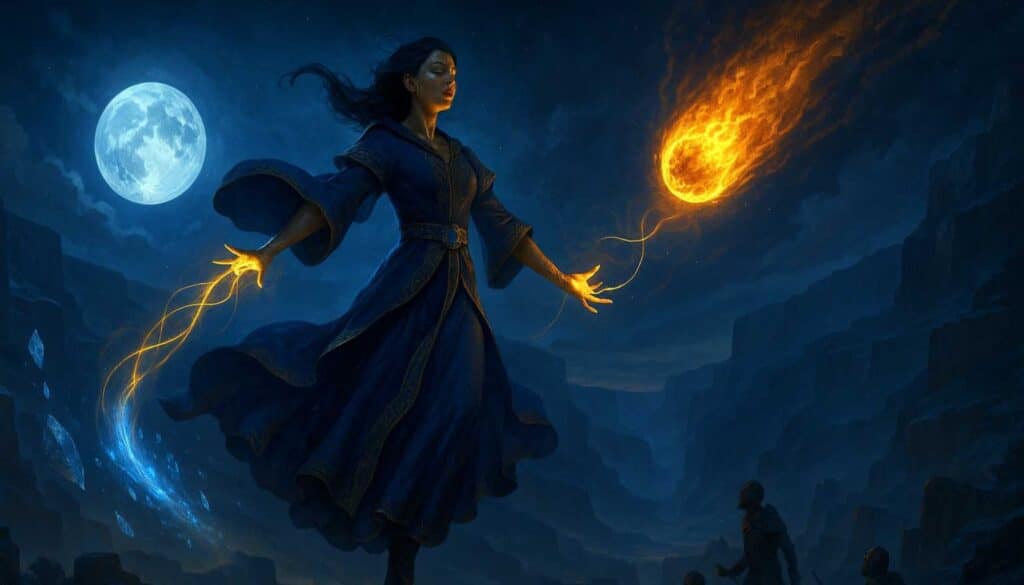
Managing Resources and Scaling Over Time
In D&D 5.5e, even the mightiest Wizard is bound by the finite nature of spell slots and daily preparation. It’s a careful calculus: burn too bright, and you find yourself helpless mid-dungeon; hold back, and you risk letting the party take avoidable hits. The art of good pacing is as vital as the art of spell selection.
You need a spread of spells for every part of the day: reliable low-level cantrips, flexible mid-level attacks, and the occasional all-or-nothing nuke for those pivotal moments. Learn to recognize when to cut loose with your top-tier bombs and when to lean on cantrips or less-flashy tricks. Save your highest-level spells for when the narrative—and your survival—demands it.
Spell preparation should align with the day’s expected threats, diversifying for resistances and just-in-case surprises. Having backup options for when damage spells run dry, such as scrolls, wands, or lower-cost utility spells, keeps you relevant long after the last Fireball goes flying.
| Spell Level | Damage Spell Example | When to Use/Alternatives |
|---|---|---|
| Cantrip | Fire Bolt | At-will, conserve slots |
| 1st | Magic Missile | Low-HP finish, reliable damage |
| 2nd | Scorching Ray | Focus fire, multiple targets |
| 3rd | Fireball | Crowd control, trash clearing |
| 4th | Vitriolic Sphere | Spread-out enemies, bypassing fire resistance |
| 5th | Synaptic Static | AoE plus debuff, psychic damage |
| 6th | Disintegrate | Single-target elimination, boss killers |
| 7th+ | Meteor Swarm | Encounter-ending, only when absolutely needed |
Scrolls and cheap wands are a Wizard’s secret weapon. Keep a stash for when spell slots are gone or for when you need to solve a problem without spending major resources. Your magic is your lifeline, and shrewd conservation means you’re always ready for that final showdown.
The most devastating Wizard is the one who always has an ace left in the sleeve when everyone else is spent. Resource management isn’t a chore—it’s the difference between legend and cautionary tale.
Team Synergy and Party Composition
Wizards shine brightest when the party works as one. The difference between an average and a legendary high-damage Wizard isn’t just raw numbers; it’s the context of teamwork, tactics, and everyone playing to their strengths. Tanks and melee characters hold the line and pin threats; controllers clump up foes for easy targeting; buffers and debuffers prime your spells to land when it matters most.
An ideal party recognizes your potential and helps you maximize it. A Bard’s Inspiration boosts your spell saves when it matters, while martial classes can herd enemies or grapple them to keep them in splash zones. Communication and coordination, not just fireballs, are what wipe encounters off the map.
Roaming solo, your spells are just fireworks. In a team, they are a symphony—the crescendo to a flawless plan. Set up combos, feed off one another’s strengths, and build a rhythm where your offensive power is the punchline, not the only joke.
Unleash at the right moment, in the right place, with a party behind you—and watch devastation become artistry.
Strategies for Team-Based Wizard Damage:
- Tanks pin enemies, so AoE spells hit more targets
- Rogues or fighters grapple/immobilize key foes for Disintegrate
- Bardic Inspiration boosts spell save DC on crucial rounds
- Coordinated flanking lines up cones/lines for maximum effect
- Clerics use Bane/Faerie Fire to lower enemy saves vs. your spells
- Controllers funnel foes into chokepoints for Wall of Fire
- Druid’s Entangle/Spike Growth combo with area spells for extra pain
- Paladins can remove resistances or block escape routes
- Sorcerers use Twin Spell/Empowered Spell to split or boost effects
- Artificers hand out Protecting Items or temp HP buffers
- Communication to avoid friendly fire with area spell placement
- Group initiatives to stack debuffs before your big turn
- Marking or tagging high-priority targets in advance
- Fighters handle threats that get past your front line
- Using party mobility (teleports, mounts) to reposition for area attacks
You’ll find your most memorable kills don’t happen alone. Team play elevates your damage not just with bonuses, but with stories—the legend of the time your firestorm and the fighter’s grappling takedown wiped out an ogre army in one round.
⚔️ Fantasy RPG Random Tables Books
Make life as a Gamemaster easier…
If you play Dungeons & Dragons, Pathfinder, or other fantasy RPGs, this
RPG random tables series
is packed with encounters, NPCs, treasure, and more. Available in eBook or print—either way, you’ll have a wealth of adventure ideas at your fingertips.
True power is never solitary. Remember that synergy and support turn even the most glassy of cannons into forces of nature.

Final Thoughts on Playing a High-Damage Wizard
The high-damage Wizard in D&D 5.5e (2024) is the ultimate paradox: fragile but fearsome, mortal but mythic, a strategist one moment and an unstoppable force the next. Intelligent spell selection, sharp positioning, and resourceful pacing are your main tools—numbers alone will not carry you to greatness.
It is not merely about the biggest dice or the flashiest spell effects. True power comes from understanding when to unleash and when to hold back, how to twist the terrain and the odds to your favor, and how to work as the mage in a symphony of heroes. Devastation balanced with caution: that’s the real magic.
Your journey toward arcane dominance is also about evolution. No Wizard’s path is ever the same, and the living rules of D&D 5.5e reward creativity, adaptability, and tactical finesse. Whether blowing holes in reality or deftly avoiding every incoming axe, the high-damage Wizard is a living testament to the power of planning and the thrill of risk.
Never lose sight of the roleplay behind the numbers. Every spell slinger who scorches the battlefield should have a reason for their hunger for power, a story that turns statistics into legend and every victory into a page of living history.
With every battle, test what works and what doesn’t. Tweak, refine, and adjust—D&D is a game that rewards those brave enough to experiment and clever enough to adapt. And above all, remember: the most dazzling victories are the ones that come with a spark of danger and a flash of style.
Unleash your magic, shape the fate of worlds, and let your legend burn bright. The battlefield is yours.





